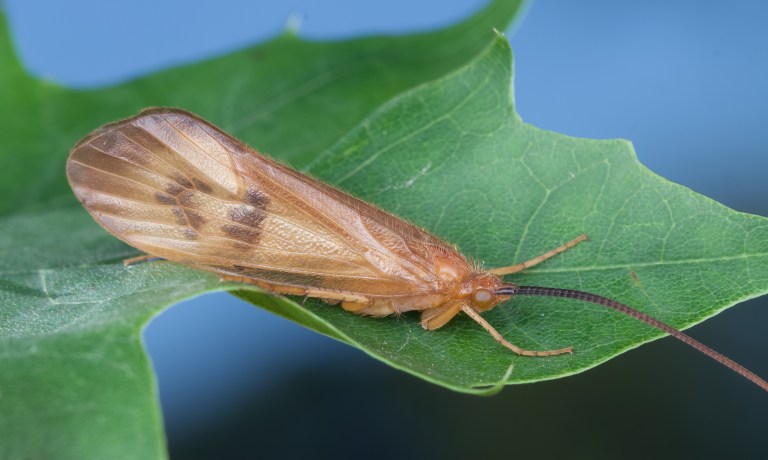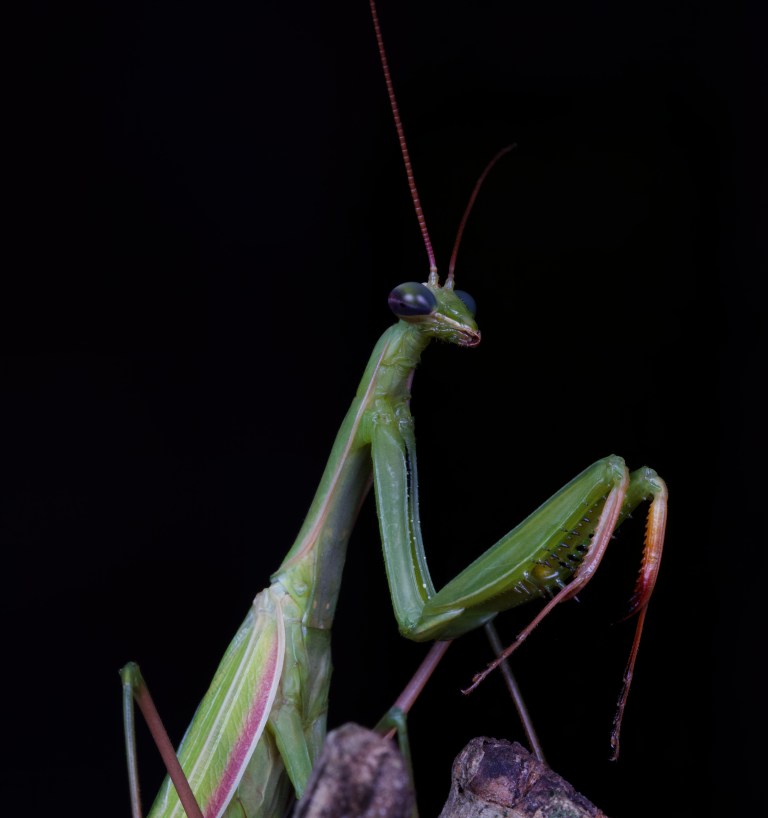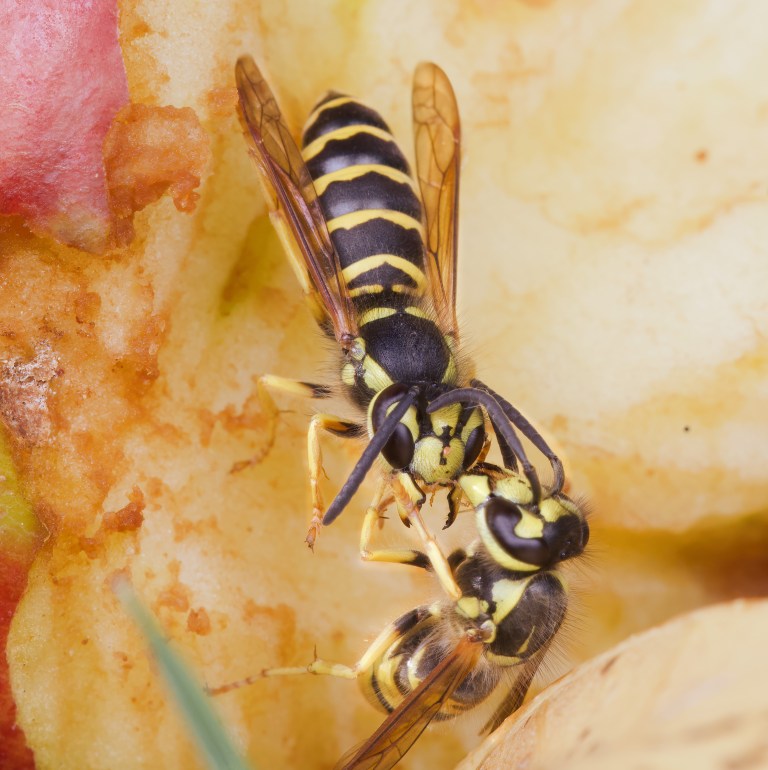Mark Sturtevant has contributed another batch of insect photos today. I’ve indented his captions and IDs, and you can enlarge the photos by clicking on them.
Here are more arthropod pictures, and this should complete the set from two summers ago. I am always behind in sharing these to various online sites since I go out a lot to the woods and fields of Michigan, where I live.
One of our larger Caddisflies is the Northern Caddisfly (Pycnopsyche sp.). Caddisflies are related to butterflies and moths, and they can look a lot like moths, but there are differences such as having hairs on their wings rather than scales. Caddisfly larvae are sort of like caterpillars, but they are aquatic and most species carry around a protective case made from either plant matter or pebbles, woven together with silk. Larvae from this genus mainly fasten together a bundle of twigs to use as a portable home.
Here is a short video about the larvae, showing that they can be quite artful in making their cases, and that their use of sticky silk under water is actually very remarkable.

Next up is a Locust Borer (Megacyllene robiniae). These wasp-mimicking beetles are common visitors on goldenrods in late summer, and their larvae tunnel into black locust trees. Since we have both in the yard, I always see these around.
Next is a European Praying Mantis (Mantis religiosa), photographed from a stage on our dining room table. Nothing too special here, but this was done for the purpose of photographing a nerdy detail about Mantids. Unfortunately, the Mantid that I found was a male, and that meant he would be a complete pain in the a** because males constantly want to move around to hunt for lady Mantids. This one frequently flew off from the dining room table, and I’d have to go chase it down. Nevertheless, the nerdy detail was eventually photographed.
Here is that detail – a specialized patch of bristles on the inside of their front femur. Mantids regularly groom themselves, and they even have a special structure on their front legs just for cleaning their large compound eyes. This has been an item of considerable discussion on one of the macrophotography web sites, and the subject has even led to a couple Facebook memes. The internet is weird that way.
Here is a video of a grooming mantis. The moment it uses its eye brush starts at 35 seconds in. It’s not that dramatic, but I geek out on it.
Moving on, here is a large Nursery Web Spider (Pisaurina mira), so-named because females build a web nursery at the tops of plants for their young. I was trying to photograph the spider with my wide-angle macro lens, but at that moment it decided to surprise me by suddenly clambering up onto the camera. I like the result.
As this set was done very late in the season, with fall moving in, there are now other late-season subjects to share. Around the yard at that time there will always be several Very Gravid Orbweavers in their webs. A couple different species are possible, but I think this one is the Shamrock Orbweaver (Araneus trifolium). I also took this one indoors to do a manual focus stack portrait by using the amazing Venus 2.5-5x super macro lens.
Here are Yellow Jackets on wind-fallen apples in the backyard– another sign that the season was ending (*sniff*). On the left is an Eastern Yellowjacket (Vespula maculifrons), and on the right is a German Yellowjacket (Vespula germanica). As is pretty common, the two species soon begin to fight over the same apple, even though there are dozens of the damn fruits on the ground that I will have to pick up later. These contests look rather dramatic, but their stingers never come out.
And finally, here is a focus stacked wide angle macro picture of autumn trees. The perspective shot is done by leaning against a tree and shooting straight up while nudging the focus a little each time. The set of pictures — maybe 8 or so, are then merged with software to give this deep focus picture.”











This is insightful as heck – I’ve seen the behavior (mantid, yellowjacket) so much but never knew of the special brush of that two different species of yellowjacket would be together …
But of course!!
[ pronounced with 19th British accent from film – or just Graham Chapman (Monty Python) ]
Thanks for the “deep focus” technique picture! Mantis’s are always fascinating! That extra neck joint might help keep the eyes clean too? Amazing how god created those eyes 🙂
Thank you. Their ability to turn their heads is always interesting. Of course they especially use that ability to scan around for prey.
The last shot of the tree gave me a bit of vertigo.
Fantastic photos as always. Thank you!
Brilliant photos, as always. I must say, that shot of the nursery web spider confused me at first.
Fantastic pictures. I love zooming in on the spider ocelli and other fine details.
Incredible photos and the links to the videos are terrific. The video of the Caddisfly larvae is really amazing. The tape they use on those specially picked stones is remarkable.
Thanks for the eye candy, and always interesting and astute commentary. Great photo of the autumn canopy. 🤩
Beautiful photos Mark! Thanks!
Great photos, but I especially love the 2 detailed photos of the praying mantis, my favorite “bug.” (As an atheist, I like to think of them as “preying” mantis.) I find them occasionally around my front porch, where I tend to a variety of potted plants. Some 10 years ago I was once privileged to find a mating pair hooked up over my front door, where they remained for the next day or two, apparently enjoying the mantis equivalent of tantric sex.
Several days or weeks later (I can’t remember now), I noticed a seemingly pregnant female mantis, alone with a bulging belly. And a while after that I was thrilled to find a mantis egg case secured to my weathered-wood backyard gate. The egg case was in a vulnerable position on the gate, though, and it was likely to get crushed if the gate were to be swung shut too hard.
I’d previously read that a mantis egg case could be moved without damage if it was scraped off carefully using a sharp, thin knife — which is what I did. With 4 map pins I secured the egg case to the painted wooden wall outside my front door, next to some wall-mounted potted plants, under the eves.
It was autumn in the San Francisco Bay Area (East Bay), and I’d read that mantis egg cases can seem dormant (or dead) over the winter, so I remained patient to see if the egg case would hatch.
Sure enough, one day in late spring I began seeing many dozens of very tiny mantis babies — very cute — emerging from the egg case, most rappelling down silk-like threads. Ultimately there may have been hundreds.
Over the next days and weeks, I saw a few of these newly hatched mantis babies getting larger. Eventually I saw only the occasional normal adult. Of course I’m not sure if all were related to the mating pair I first noticed over my front door, but it was fun to see the entire life cycle represented.
What a great story!
Thanks, Mark! It’s gratifying to know that a “bug” expert enjoyed my story. It would take some digging to find them, but I have some great photos of that mantis life cycle, though they don’t match the detailed quality of your own photos. (I rely on always carrying around an ancient iPhone SE to take pictures on the fly — so to speak.)
I’ve been an amateur entomology fan for most of my life, in particular when I got a temporary summer job in the middle 1970s for a Pennsylvania state government ecology study. My job included wading along Bucks County streams collecting caddisfly larvae — and many did indeed carry around interesting camouflaging accoutrements on themselves!
I also graphed the data from my stream collection forays, which were subsequently published in a printed report that I still have. (I fondly think of that time as a satisfying brush with being a practicing scientist.)
Gosh. Now I remember actually seeing the mantis laying that egg case. I don’t know how I could have forgotten! (Another reminder that I’m not a kid anymore.) It took maybe a half-hour (?) for the mantis to pump it out. It flew away as I watched, and I was hoping my presence hadn’t somehow interrupted the process.
Just wonderful. I always like to see how the insects are the same as here in Australia but not quite the same. Great details about each, always a joy.
These are just wonderful. Thank you for curing my arachnophobia!
Thanks. The insects are always my favorites here.
D.A.
NYC